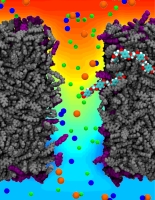Research Topics - Nanoengineering
Molecular modeling provides nanoscale images at atomic and even electronic resolution, predicts the nanoscale interaction of yet unfamiliar combinations of biological and inorganic materials, and can evaluate strategies for redesigning biopolymers for nanotechnological uses. The methodology's value has been reviewed for three uses in bionanotechnology. The first involves the use of single-walled carbon nanotubes as biomedical sensors where a computationally efficient, yet accurate description of the influence of biomolecules on nanotube electronic properties and a description of nanotube - biomolecule interactions were developed; this development furnishes the ability to test nanotube electronic properties in realistic biological environments. The second case study involves the use of nanopores manufactured into electronic nanodevices based on silicon compounds for single molecule electrical recording, in particular, for DNA sequencing. Here, modeling combining classical molecular dynamics, material science, and device physics, describes the interaction of biopolymers, e.g., DNA, with silicon nitrate and silicon oxide pores, furnishes accurate dynamic images of pore translocation processes, and predicts signals. The third case involves the development of nanoscale lipid bilayers for the study of embedded membrane proteins and cholesterol. Molecular modeling tested scaffold proteins, redesigned lipoproteins found in mammalian plasma that hold the discoidal membranes in shape, and predicted the assembly as well as final structure of the nanodiscs. In entirely new technological areas like bionanotechnology qualitative concepts, pictures, and suggestions are sorely needed; the three exemplary applications document that molecular modeling can serve a critical role for the new bionanotechnology, even though it may still fall short on quantitative precision.

image size:
268.6KB
made with VMD
Papers
Electrically induced conformational change of peptides on metallic nano-surfaces. Yi Chen, Eduardo R. Cruz-Chu, Jaie Woodard, Manas Ranjan Gartia, Klaus Schulten, and Logan Liu. ACS Nano, 6:8847-8856, 2012.
Computational investigation of DNA detection using graphene nanopores. Chaitanya Sathe, Xueqing Zou, Jean-Pierre Leburton, and Klaus Schulten. ACS Nano, 5:8842-8851, 2011.
Molecular control of ionic conduction in polymer nanopores. Eduardo R. Cruz-Chu, Thorsten Ritz, Zuzanna S. Siwy, and Klaus Schulten. Faraday Discussions, 143:47-62, 2009.
Ionic current rectification through silica nanopores. Eduardo R. Cruz-Chu, Aleksei Aksimentiev, and Klaus Schulten. Journal of Physical Chemistry C, 113:1850-1862, 2009.
Nanoelectromechanics of methylated DNA in a synthetic nanopore. Utkur M. Mirsaidov, Winston Timp, Xueqing Zou, Valentin Dimitrov, Klaus Schulten, Andrew P. Feinberg, and Greg Timp. Biophysical Journal, 96:L32-L34, 2009.
Modeling transport through synthetic nanopores. Aleksei Aksimentiev, Robert K. Brunner, Eduardo Cruz-Chu, Jeffrey Comer, and Klaus Schulten. IEEE Nanotechnology, 3:20-28, 2009.
Computer modeling in biotechnology, a partner in development. Aleksei Aksimentiev, Robert Brunner, Jordi Cohen, Jeffrey Comer, Eduardo Cruz-Chu, David Hardy, Aruna Rajan, Amy Shih, Grigori Sigalov, Ying Yin, and Klaus Schulten. In Protocols in Nanostructure Design, Methods in Molecular Biology, pp. 181-234. Humana Press, 2008.
O2 migration pathways are not conserved across proteins of a similar fold. Jordi Cohen and Klaus Schulten. Biophysical Journal, 93:3591-3600, 2007.
Exploring molecular oxygen pathways in Hanseluna Polymorpha copper-containing amine oxidase. Bryan J. Johnson, Jordi Cohen, Richard W. Welford, Arwen R. Pearson, Klaus Schulten, Judith P. Klinman, and Carrie M. Wilmot. Journal of Biological Chemistry, 282:17767-17776, 2007.
Disassembly of nanodiscs with cholate. Amy Y. Shih, Peter L. Freddolino, Stephen G. Sligar, and Klaus Schulten. Nano Letters, 7:1692-1696, 2007.
Assembly of lipids and proteins into lipoprotein particles. Amy Y. Shih, Anton Arkhipov, Peter L. Freddolino, Stephen G. Sligar, and Klaus Schulten. Journal of Physical Chemistry B, 111:11095-11104, 2007.
Assembly of lipoprotein particles revealed by coarse-grained molecular dynamics simulations. Amy Y. Shih, Peter L. Freddolino, Anton Arkhipov, and Klaus Schulten. Journal of Structural Biology, 157:579-592, 2007.
The role of molecular modeling in bionanotechnology. Deyu Lu, Aleksei Aksimentiev, Amy Y. Shih, Eduardo Cruz-Chu, Peter L. Freddolino, Anton Arkhipov, and Klaus Schulten. Physical Biology, 3:S40-S53, 2006.
Beyond the gene chip. J. B. Heng, A. Aksimentiev, C. Ho, V. Dimitrov, T. Sorsch, J. Miner, W. Mansfield, K. Schulten, and G. Timp. Bell Labs Technical Journal, 10:5-22, 2005.
Simulation of the electric response of DNA translocation through a semiconductor nanopore-capacitor. Maria E. Gracheva, Anlin Xiong, Aleksei Aksimentiev, Klaus Schulten, Gregory Timp, and Jean-Pierre Leburton. Nanotechnology, 17:622-633, 2006.
Stretching DNA using an electric field in a synthetic nanopore. J. B Heng, A. Aksimentiev, C. Ho, P. Marks, Y. V. Grinkova, S. Sligar, K. Schulten, and G. Timp. Nano Letters, 5:1883-1888, 2005.
Microscopic kinetics of DNA translocation through synthetic nanopores. Aleksij Aksimentiev, Jiunn Benjamin Heng, Gregory Timp, and Klaus Schulten. Biophysical Journal, 87:2086-2097, 2004.
Sizing DNA using a nanometer-diameter pore. J. B. Heng, C. Ho, T. Kim, R. Timp, A. Aksimentiev, Y. V. Grinkova, S. Sligar, K. Schulten, and G. Timp. Biophysical Journal, 87:2905-2911, 2004.
Ion-nanotube terahertz oscillator. Deyu Lu, Yan Li, Umberto Ravaioli, and Klaus Schulten. Physical Review Letters, 95:246801, 2005. (4 pages).
Empirical nanotube model for biological applications. Deyu Lu, Yan Li, Umberto Ravaioli, and Klaus Schulten. Journal of Physical Chemistry B, 109:11461-11467, 2005.
Screening of water dipoles inside finite-length armchair carbon nanotubes. Yan Li, Deyu Lu, Slava V. Rotkin, Klaus Schulten, and Umberto Ravaioli. Journal of Computational Electronics, 4:161-165, 2005.
Coarse grained protein-lipid model with application to lipoprotein particles. Amy Y. Shih, Anton Arkhipov, Peter L. Freddolino, and Klaus Schulten. Journal of Physical Chemistry B, 110:3674-3684, 2006.
Finding gas diffusion pathways in proteins: Application to O2 and H2 transport in CpI [FeFe]-hydrogenase and the role of packing defects. Jordi Cohen, Kwiseon Kim, Paul King, Michael Seibert, and Klaus Schulten. Structure, 13:1321-1329, 2005.
Approaches to developing biological H2-photoproducing organisms and processes. Maria L. Ghirardi, Paul W. King, Matthew C. Posewitz, Pin Ching Maness, Alexander Fedorov, Kwiseon Kim, Jordi Cohen, Klaus Schulten, and Michael Seibert. Biochemical Society Transactions, 33:70-72, 2005.
Molecular dynamics and experimental investigation of H2 and O2 diffusion in [Fe]-hydrogenase. Jordi Cohen, Kwiseon Kim, Matthew Posewitz, Maria L. Ghirardi, Klaus Schulten, Michael Seibert, and Paul King. Biochemical Society Transactions, 33:80-82, 2005.
Genetically engineered gold-binding polypeptides: Structure prediction and molecular dynamics. Rosemary Braun, Mehmet Sarikaya, and Klaus Schulten. Journal of Biomaterials Science, 13:747-758, 2002.



